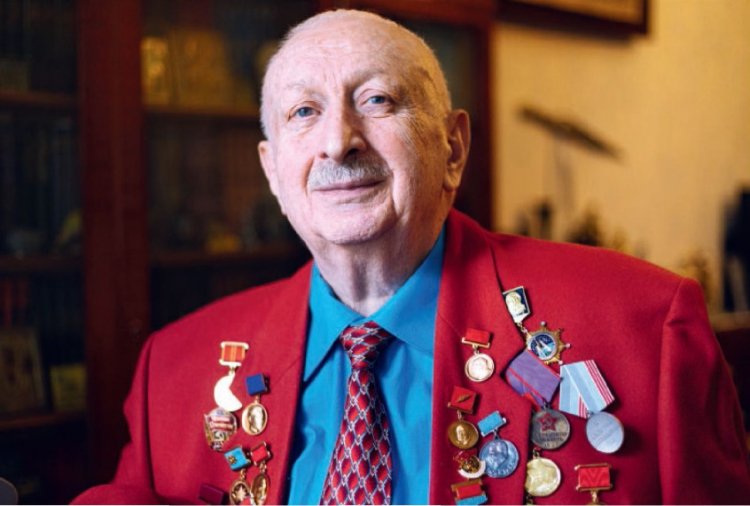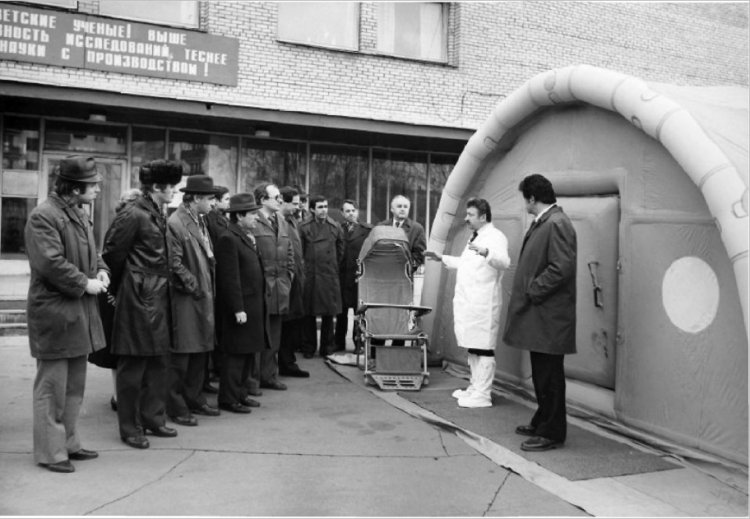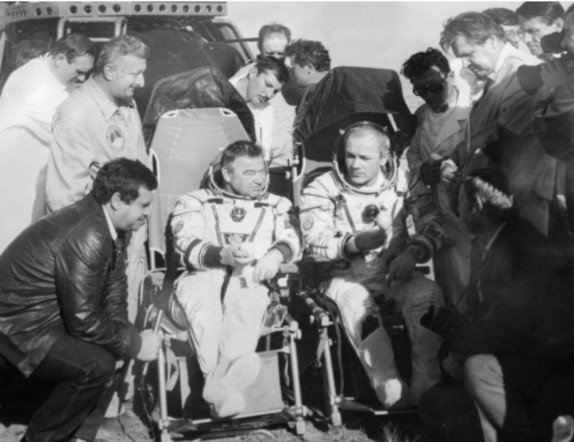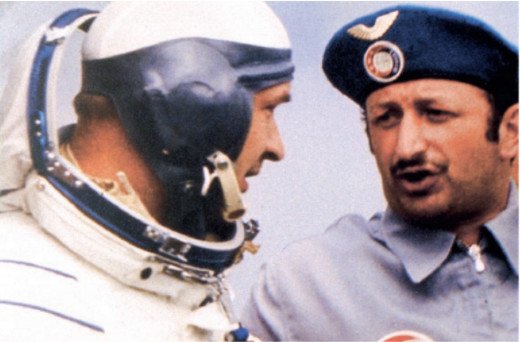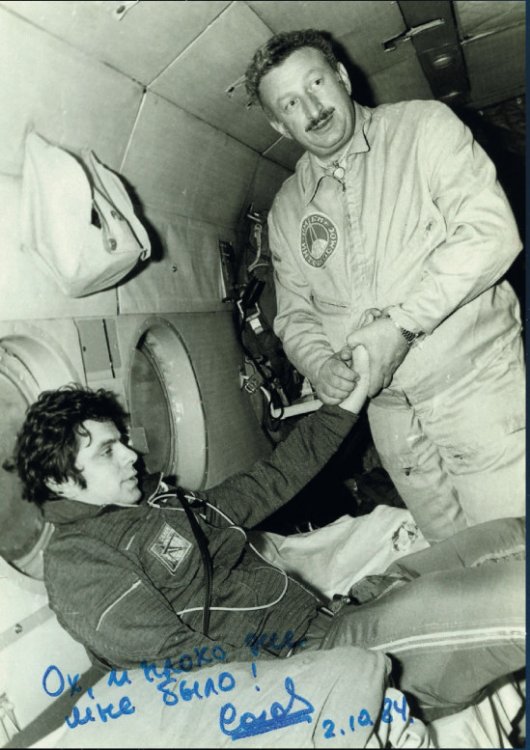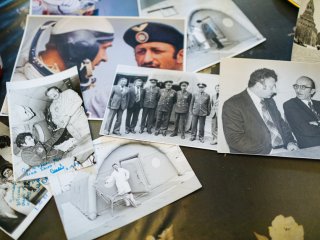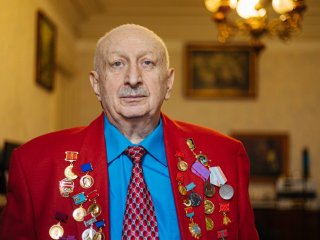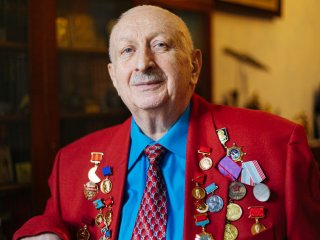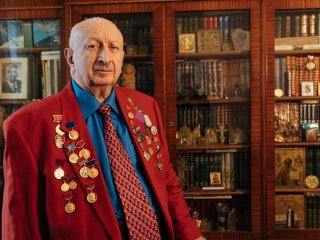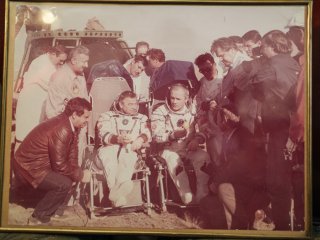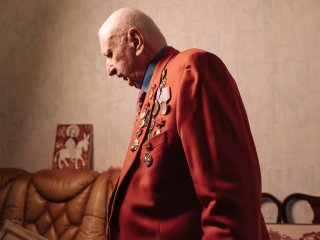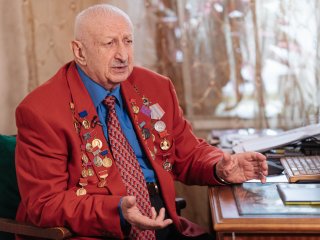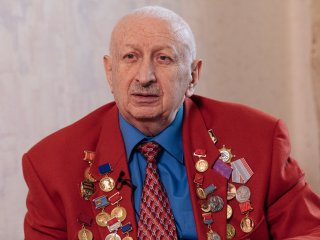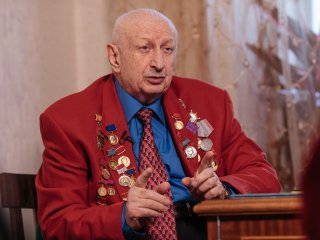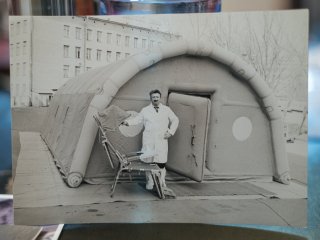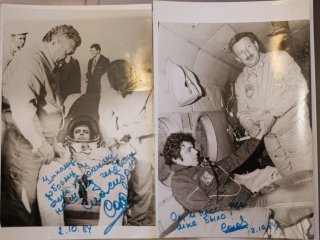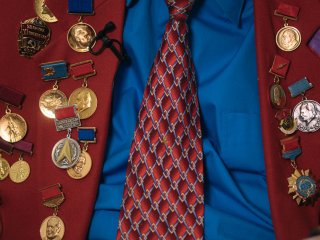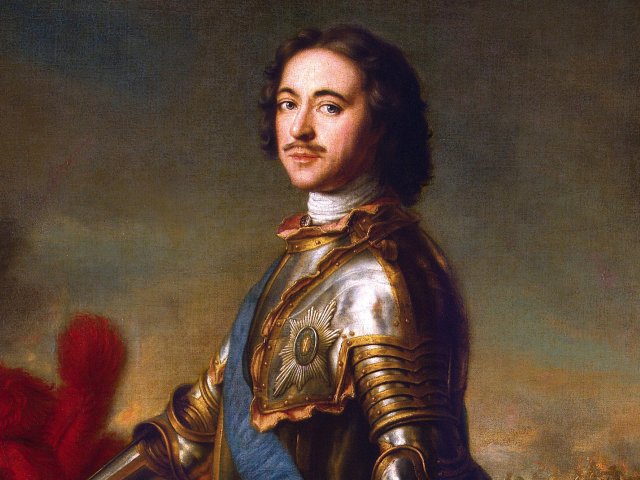Levan Longinozovich Stazhadze is a doctor of medicine, professor, full member of the International Astronautics Academy and a real groundbreaker. He was one of the first emergency anesthesiologists in our country being in charge of the first department at the Sklifosovsky Research Institute of First-Aid, and one of the founders of new disaster medicine service which has been successfully functioning in Moscow to the present day. In early 1970s, he organized and took charge of a new department for medical support of piloted flights at the Institute of Medico-Biological Problems, Academy of Sciences of the USSR. His present reminiscences about those wonderful years are devoted to the 60th anniversary of the first piloted space flight.
Levan Longinozovich, why did you choose intensive-care medicine as primary profession?
I have been working in the field of emergency medicine for the whole of my life. At the very beginning, it was the emergency medical care that appealed to me. My father (L.M. Stazhadze, founder and director of legendary Moscow-based restaurant Aragvi – ed. note) was on friendly relations with outstanding surgeon academician A.A. Vishnevsky. The academician often visited our home, and we many times met him informally. When I was graduating from the medical institute, he offered me a job at his medical center. Everybody was sure that I would accept this offer and become a surgeon. Moreover, I wanted to deal with cardiovascular surgery too. However, life had other plans, as the saying goes.
The postgraduate job assignment ceremony took place on April 12, 1961. Now, everybody knows this date. At that time, it was an ordinary spring day. I enter the room where the commission dealing with job assignment was sitting, and suddenly something all hell is breaking loose. The people jump up from their seats, run somewhere, swing arms and shout, “A man in space!” Inexpressible delight and enthusiasm! Yuri Gagarin’s space flight inspired all of us. It suddenly became clear to me that I also should accomplish a feat.
What did you do?
I took a decision to work at a district polyclinic as general practitioner. It stands to mention that early 1960s were the period of construction boom. The people were resettled from basements and semi-basements to new dormitory districts. The shortage of doctors, especially general practitioners was obvious. So, I chose a job in one of new districts of Moscow that was called Zastava Ilyicha. At that time, there were villages there. I started my medical career from scratch.
Didn’t you regret having refused from the job at Vishnevsky’s institute?
No, because the work as general practitioner is a good school. Even now, I recommend working at a district polyclinic for a couple of years to my students. It is a school of unsupervised work which teaches one to take decisions on the spot. Later, a part-time job in emergency aid was offered to me, and I accepted the offer. I could be on duty for 24 hours without getting tired. I liked all these challenges and was not afraid of them.
Then, you made it to the Sklifosovsky Institute, didn’t you?
Working at the polyclinic, I visited both the Institute of Experimental and Clinical Surgery and Sklifosovsky Institute where conferences devoted to injuries, neuro-traumas, burns, etc. were held. All acute surgical pathologies were gathered: myocardial infarction, hypertensive crisis, acute abdomen… I learned how to read and understand electrocardiogram, far from every physician is capable of. I even completed a special course under the guidance of A.M. Damir, outstanding therapist who treated top public officials.
He was the father of Tatiana Damir, wife of S.P. Kapitsa founder of our magazine.
Damir had two daughters – Elena and Tatiana. Tatiana graduated from the Biological Faculty of the Moscow State University, while Elena was the graduate of medical institute. She became one of the first anesthesiologists and head of anesthesiology department at the Botkin Hospital. We were on friendly terms, and I often visited their country house in Nikolina Gora, which was a gift of Stalin.
It was as follows. Stalin suffered from strange pain in precordial region, and lying motionless for 30 days was prescribed to him. It was a method of treating infarction at that time. Stalin refused. Then, the officials invited Alim Damir who examined head of state and said, “Get up, Iosif Vissarionovich.” Stalin was surprised, “What do you mean? They told me to lie down as infarction patient.” “Stand up and do not worry.” At that time, he studied false angina, pains that imitate heartaches. Damir assumed serious responsibility, because we would have hardly seen him again, if something happened. However, he was right.
So Alim Damir was offering consultations at our polyclinic. In general, it was generally accepted – all outstanding surgeons and therapists would receive patients at district polyclinics once a month free of charge. It was good practice.
Was it Alim Damir who offered a job at Sklifosovsky Research Institute to you?
No, he did not do it personally. Yet, his lectures and conversations with him led me to the understanding of the fact that a job at Sklifosovsky Institute was what I needed. Another person, a friend of me and B.A. Petrov, outstanding surgeon, academician and disciple of S.S. Yudin, brought me there. He asked me, “What do you want to be?” At that time anesthesiology was gaining momentum. I replied that I wanted to become an anesthesiologist. So, I was sent to anesthesiology department with first official anesthesiologist of the USSR B.G. Zhilis in charge.
As there were very few anesthesiologists at the Sklifosovsky Institute, we worked in all departments including the ones of gynecology (where abdominal pregnancy patients suffering from serious loss of blood were brought), trauma, burns, etc. Several years later, a center for treating acute toxic exposure was founded there. Thus, we were mastering all pathology cases and could be on call for 24 hours, 7 days a week. Now, anesthesiologists specialize in only one of them – cardiology, neuro-trauma, burns, etc. In my time, there was no such division. It played a decisive role, when anesthesiologists for brigades of emergency surgical aid were chosen to support space flights.
How it happened that you joined the space community?
In 1970s, the question of long-duration flights came up, though there was no orbital station yet. The longest flight as of that time (17 days) was performed by cosmonauts A.G. Nikolayev and V.I. Sevastyanov in 1970. The descent module with habitable room had a form of ball. The habitable room was small like the module itself. So, the cosmonauts spent 17 days in space without physical exercise in gravity-free state. By the end of the flight, they adjusted to absence of gravitation and felt no discomfort. However, when the flight was over, they found themselves in conditions of terrestrial gravity without any adaptation period. Both of them were actually, truth be told, in collaptoid state. In fact, a rush of blood to the head occurs in space which leads to mild headaches and mottled vision. When they finally landed, blood rushed away from the head to the lower limbs, and the cosmonauts started suffering from anemia. Actually, it was functional apoplexy.
This fact caused serious commotion. Some specialists and cosmonauts began saying that the duration of the flight should be limited to two weeks maximum. The specialists from another group with director at the Institute of Medico-Biological Problems, academician O.G. Gazenko at the head insisted on the fact that longer space flights were possible, yet special prophylactic measures were needed – physical exercises, various simulation training systems, etc. Moreover, the measures should be taken only after studying the issue thoroughly.
As longer space flights were planned, Deputy Health Minister A.I. Burnazian, who dealt with different areas, including space flight, made a decision on including anesthesiologists into the brigades of emergency surgical aid. Eventually, an order of two ministers – Defense Minister A.A. Grechko and Health Minister B.V. Petrovsky – was issued. The ministers ruled to add intensive-care anesthesiologists to the brigades of emergency surgical aid. Thus, 18 folders were laid on Burnazian’s table, including my one.
L.L. Stazhadze presents his innovative development – an inflatable tent which was later pitched in the place of landing
All of the proposed specialists were good and strong guys. I know all of them. The group included doctors from the Vishnevsky Institute of Surgery, Petrovsky Research Institute of Experimental and Clinical Surgery, First Medical Institute and Botkin Hospital. A.A. Bunyatian was the chief anesthesiologist of the Health Ministry at that time. Burnazian told him, “The guys are good, but, look, one of them deals with lung surgery, the second candidate specializes in heart surgery, the third one is an expert in vascular surgery, etc. As for Stazhadze from the Sklifosovsky Institute, he has anesthetized patients during surgical operations for injuries, burns, neuro-trauma, spine injury, abdominal traumas, hemorrhage, poisoning…” Burnazian immediately summoned me to his office. I will never forget the conversation with this man. He belonged to a special bunch of people, state-minded ones. He was the holder of several Orders of Lenin. First, he supervised nuclear industry and then was commissioned to take charge of the space one. He told me, “We recommend you for classified activity. It is a very responsible job. You have to move to the Star City for the period of two weeks and master all necessary skills. You will learn how to put on and take off the space suit, administer medical aid, work with descent module, etc.
The first flight that I worked for was the one to the first space station – Salyut-1 – in April 1971. The crew consisted of V.A Shatalov, A.S. Yeliseyev and N.N. Rukavishnikov. The coupling failed to take place due to technical reasons, yet I saw how the descent module looked like and learned what term soft landing meant. Yeliseyev and Shatalov performed their third flight and were adapted to abrupt change of conditions, while for Rukavishnikov it as the first space flight, and he only started to get adjusted to gravity-free state. Thus, he suffered from adaptation syndrome. Having come back from the place of landing, I reported the situation to Burnazian. Then, I told him, “Avetik Ignatyevich, we should equip the place perfectly. I have seen the soft landing. Yes, the cradles function well, everything is taken care of. Yet, this landing is not so soft and safe.” He asked me, “What do you need?” I handed over a whole list of things to him. He ordered to all instances to provide me with everything that was required. Though it stands to mention that not all of the bosses agreed with him.
Finally, a small operating room was organized inside MI-8 helicopter. By the way, the military took my side backed my initiative. They even had to remove one fuel tank from the helicopter, which reduced the helicopter’s moment arm. Instead of the fuel tank, they installed a field operating table and attached an anesthetic machine to it. Avetik Burnazian and Armen Bunyatian helped me to get a very good French defibrillator, a real portable device.
Did all these things come in useful?
The next space flight took place in 1971 and was performed by V.N. Volkov, G.T. Dobrovolsky and V.I Patsayev. It was a real tragedy. Decompression occurred in space. The crew had successfully completed the mission in the station and disengaged from it. The next task was to jettison the habitable section from the descent module. At that moment, when they were in space, at the altitude of about 150 km in vacuum, the habitable section was jettisoned together with the plug for some reason, and a hole of 2 cm in diameter formed up. If they were in space suits, the cosmonauts would have remained alive getting off with concussion. However, the air flew out of the module immediately.
What happened inside? The effect was like the one of glass cups applied onto the back. The vacuum inside the cup makes human skin reddish black, as blood is rising. Can you imagine how strong the effect was in their case? The body turns into a big bruise, while blood comes out of the vessels.
What did we see? After the soft landing, the module fell on the side. It was a space flight with duration of 24 days, and the cosmonauts were welcomed by pioneers with drums and horn, local officials with loafs of bread and beautiful girls. As per regulations, the hatch was to be opened by either the representative of manufacturing plant or the first person who reached this module. A military physician, a paratrooper was this person. He inserted the key, turned it, opened the hatch and saw three black faces. He started shouting immediately, “Doctors, help!”
I probably set my own record in speed of running, though I carried a heavy back of intensivist with me. Having seen the cosmonauts, I gasped out the phrase which later became commonly accepted, “No signs of life (stone dead)!” It was interesting that I had never heard this phrase before. I do not know the origin of it.
As far as I know, you were trying to resuscitate them for a long enough time.
It was not easy to take them out. Fortunately, there were specialists knowing the tricks of fixing cradles and belts among us. The cosmonauts were taken out of the module, and we performed cardiopulmonary resuscitation. I started resuscitating Vladislav Volkov, while my assistants V.P Leonov and A.A. Lebedev attended to Georgy Dobrovolsky and Viktor Patsayev. I introduced a needle with syringe to his heart in order to inject adrenaline into it. The plunger few out and I saw foamy black blood in the syringe. It became clear to me at once that it was explosive decompression.
However, we still performed the whole complex of resuscitating procedures, which took us an hour. Security officers were recording everything with a cine camera. Then, we loaded together with dead bodies into AN-12, a big transport jet of the Air Force equipped with a pressurized cabin. This cabin is designed to house eight people. However, there were 16 of us in it including the dead bodies on stretchers.
We landed at Chkalov military airport near Moscow. Immediately after landing we were brought to the Burdenko Military Hospital. There were many top officials there including A.I. Burnazian, B.V. Petrovsky and A.A. Bunyatian. Armen Bunyatian asked me, “Have you done the utmost of your power?” I answered, “Absolutely all I could.” “Are you sure that it is explosive decompression?” “I am 100% sure.”
Then forensic pathologists arrived – the most well-known specialists were invited. They started performing autopsy. While they were making the diagnosis and described the case, we were staying there for several hours. The Bunyatian entered the room where we were sitting and said, “The bosses ordered to bring you home by car. I will meet you at the headquarters of Air Force tomorrow. You are to write down what had happened, from beginning to end. Take a rest tonight.” My colleague and I come out of the room and say, “If the diagnosis were not confirmed, they would hardly offer a car to each of us…” However, the diagnosis was confirmed.
L.L. Stazhadze (left) at the place where V.A. Dzhanibekov and G.M. Grechko made the landing (1985)
Is it since that time that the cosmonauts have performed the landing only with their space-suits on?
Yes, otherwise fatal injuries are possible. Immediately after this tragedy, a question was raised on founding a special service under the Institute of Medico-Biological Problems. I received the offer to take charge of the laboratory for medical support of piloted flights.
As far as I know, there have been no such tragedies ever since. With the rise in duration of space flights, our tasks would become increasingly more versatile.
The problems related to enhancing working ability enjoyed top priority. No one needed cosmonauts just sitting and looking through the viewing port. They had to accomplish serious tasks and perform spacewalks. I was immediately introduced to the group with G.I. Severin, director general at Zvezda Plant, in charge. It is a serious enterprise. Seeing Orlan spacesuit for the first time, I asked Gay Severin, “What did you called me for? What can I do?” Orlan was designed so that the cosmonaut could not touch one finger with another one. Each body part was completely separated from another one. It looked as if the body, arms and head were placed into individual safes. What could I do if something happened? Gay Severin answered, “You are the physician, so think about it yourself. I have many other problems to cope with.”
Did you manage to invent anything?
I started looking through old medical literature. I understood that there would be no opportunity of serious diagnostics and started studying the notes of zemsky doctors. Gradually, the idea of how to prevent cardiac or respiratory disorders without touching the patient came to my mind.
After the return of Soyuz-Apollo mission (1975). The photo shows the moment when L.N. Stazhadze asks V.N. Kubasov, “What is wrong with Leonov?”
For instance, if you feel some heart problem and see nobody nearby, you should start coughing. It will allow you to raise the blood flow to heart. I had such classic experience during the landing of Soyuz-Apollo mission. Cosmonaut Leonov suddenly felt seedy. He turned pale, and perspiration appeared on his forehead. It stands to mention that Leonov was a very physically strong guy. He was superior to all other cosmonauts in lungs volume and could hold his breath for about 5 minutes.
So, I see that he is unwell. Both the American and our reporters are running towards him. I tell Alexey, “You should breathe in and then breathe out with a cough.” It is the so-called modified Valsalva test. His face starts turning pink. At that moment, the journalists approach him, and he gives interview jointly with Kubasov as if nothing has happened. There are methods to relieve headache or reduce arterial pressure by way of stimulating the hand by finger or pinching earlobe.
Is it Chinese medicine?
No, not entirely Chinese. Any pathologic process has an organic component. Besides, there is perifocal edema. It is for this very reason that various witchdoctors and spirit-healers produce successful enough results. It is called tambourine effect. It allows for throwing out amines and endorphins, so the perifocal edema dissipates. The patient starts feeling better. Moreover, such improvement may prove to be decisive. It will be enough for the patient to remain alive. There were cases when we used medications during the space flight. These stories are many. When I worked in the field of space medicine, it was considered for some reason that the reports about space flights should describe the course of flight as normal and the cosmonauts as feeling well
L.L. Stazhadze measures pulse rate of cosmonaut V.A. Solovyev after the long-duration flight in an inflated tent on the site of landing
Is it wrong?
I think that such practice is detrimental. Many secrets are revealed only now. For instance, P.I. Belyayev and A.A. Leonov had a tough time, as they landed in taiga, while it was announced that they were in a sanatorium. They survived only thanks to their own gumption. Abnormal situations including the ones related to health often occurred during the spaceflights. On the contrary, the reports should say what good guys the cosmonauts were, and how they managed to avoid early landing. Fraud costs a lot as a rule.
Gradually, our laboratory was expanding and finally was transformed into a department. We had to develop new techniques of providing medical care. Afar more serious list of medications was drawn. We continued making training flights with the cosmonauts. It helped us to get an insight into their physiological characteristics, degree of fitness, ability to refresh, etc. In space, adaptive capability is very important along with the ability of tolerating extreme physical loads. The quicker you recover, the better. It is the so-called internal reserve of human organism. Serious research activity started, my colleagues began defending dissertations. I had an excellent team. In particular, it included V.V. Bogomolov (now, he is a doctor of medicine, professor), deputy director at the Institute of Medico-Biological problems I.B. Goncharov (also doctor of medicine and professor). Unfortunately, he died last year due to coronavirus.
I know that you have to work as psychologist as well…
Things happen. For instance, two cosmonauts quarreled with each other once during a long-duration flight. Such things happen, yet people forget about this quarrel half an hour or an hour later as a rule. However, this time the quarrel looked serious, and this fact started affecting the flight program. The whole collective gathered. A.S. Yeliseyev was the head of the Mission Control Center (MCC) at that time. We tried to talk to them and bring them to reason, organized unscheduled communication session with families, threatened them with early landing, etc. All these measures failed.
Didn’t the group include a psychologist?
There was a military psychologist in the team. He suggested organizing a communication session with Secretary General of the CPSU Central Committee Leonid Brezhnev. However, this variant was rejected at once.
Suddenly Yeliseyev gives a black look at me and says, “Why does the medical specialist keep silent?” I answer, “Alexey Stanislavovich, an interesting story has come to my mind. Once Aristotle paid attention to his disciples having begun to quarrel with each other. In the evening, he set an incorrect question to them and ordered to prepare the answer to it by the next morning. They decided that he had gone made and racked their brains for the whole night thinking what they should do about it. Asa result, they completely forgot about their differences.”
I suggested setting such a task to the cosmonauts and waiting till silent orbit started (such silent orbits lasted up to 1.5jours at that time). A.S. Yeliseyev liked the idea. The MCC gave some strange command to the cosmonauts. Frankly speaking, I do not remember what kind of command it was. When the time for new communication session came, both of them would shout interrupting each other that we had gone crazy and wanted to destroy the station. Thus, they came together in their angry and stopped having a grudge against each other.
Levan Longinozovich, do you think that piloted spaceflights are necessary? Or shall we let robots do it? It is much safer this way, isn’t it?
Cosmonautics should be diversified and versatile. Deep space ought to be explored by robots. As far as our nearest satellites are concerned, however, the idea of human settlements looks reasonable. We should expand the boundaries of our world coming to the eras where no man has gone before. Moreover, it is necessary, as the Moon is a wonderful launch pad for exploring deep space. In general, space technologies always mean a powerful leap forward. It is a solution for a tremendous number of new technological problems, the techniques which are later used in everyday life.
Are you still in contact with the cosmonauts? Do they ask you for a piece of advice?
We certainly are in touch. We call each other and complain about the state of health. Sometimes they seek my advice. We are on friendly relations. Last year, we celebrated V.A. Aksenov’s 85 birthday anniversary. I was sitting at one table with V.A. Dzhanibekov and V.P. Savinykh. We were laughing and recalling different moments of our joint work. Suddenly, I say, “Look, I know why they have put me at the table with you.” They exchange glances, “Why?” I say, “It is because we are fellow-professionals.” At first, they were at a loss, but then Dzhanibekov said, “You are right! We have been resuscitating Salyut-7 station, while you an intensive-care specialist dealing with resuscitation.”
Interviewer: Nataliya Leskova
Levan Longinozovich Stazhadze, doctor of medicine, professor, full member of the International Astronautics Academy
*All images are provided by L.Stazhadze
